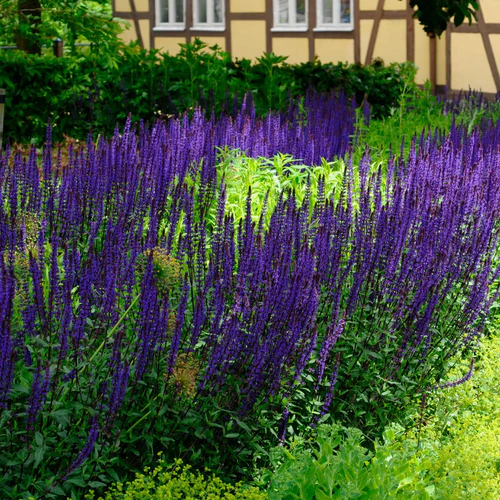Salvia (or ‘sage’) is an attractive and fragrant addition to the summer garden. It is known to be quite resilient, being both deer & rabbit-resistant. If you are looking for a reliable hardy plant for your garden this June, check out everything there is to learn about Salvia in this weeks blog, Salvia 101.
About Salvia

Salvias belong to the family of Lamiaceae and are known for being colorful. The flowers are dense and have a tubular shape, while the stems & leaves are usually velvety. These plants can be found in various shades like purple, blue, red, pink & white.
Salvia, derived from the Latin word salvere meaning “to heal,” and has been used centuries ago by the Greek & Roman societies to improve memory and enhance cognitive functions.
Although “salvia” and “sage” are often used interchangeably, the former usually refers to ornamental plants, while the latter is for culinary herbs. Additionally, there are several varieties of garden sage that have attractive ornamental features.
Resistant
Salvia plants are lucky, as they are usually left undamaged by deer and rabbits due to the pungent odor of their distinctive leaves. This scent works as a natural deterrent to other pests in the garden.
Tolerant
Salvia plants are highly tolerant of both heat and drought, making them ideal for the summer garden. They come in a wide variety of shapes & sizes, ranging from 18 inches to 5 feet tall! Growing them in containers is also possible and can be beneficial if you have limited space.
Hardy
Before selecting salvias to add to your garden, it’s important to note that the hardiness of the species varies across different regions. Some are best kept as annuals while others can survive as perennials. There’s a large selection of both types available.
Varieties of Salvia

There are nearly a thousand species of salvias, of which some are perennial and tender. To make up for their lack of winter hardiness, they are often treated as annuals in regions where they cannot survive the cold weather.
Annuals
For regions with warmer climates, certain Salvias are known to be perennial plants that persist from one season to the next. However, most of these varieties are usually grown as annuals that need replacing yearly. Popular Annuals include: Scarlet Sage or Texas Sage, Pineapple Sage and Bedding Sage.
Perennials
This is an ideal group of plants for cold climates, ranging in height from 12-24 inches and producing blooms between late spring and early summer. The following salvias are usually grown as perennials; Azure Sage, Peruvian Sage, Autumn Sage and Hybrid Sage.
How to Plant Salvia

Salvia requires full sunlight and slightly acidic to neutral soil pH for proper growth. The blooming period typically ranges from spring to fall and flowers come in various colors like blue, pink, purple, red, white & yellow. This plant is hardy in the zone 5-10. To plant your own Salvia at home, follow these easy instructions:
1.) Dig the ground to a depth of 12 inches & remove any stones or roots. Then add in 3 inches of compost for extra nutrient content to make the soil more fertile.
2.) When growing plants in pots, it is advisable to add some grit or sharp sand to the compost in order for better water drainage. Plants planted in the garden soil don’t require additional feeding as they can gain nourishment from atmospheric conditions.
3.)After taking the plant out of its pot, put it in a hole that is three times the size of the plants container, so that the top of its root ball is even with the soil surface.
4.)Depending on the type of plant, space plants at a distance of 1 to 3 feet apart.
5.) After planting the desired species, be sure to pack the soil around it firmly yet gently. Afterwards, give the plant its first good soak of water.
How to Care for Salvia
Watering Salvia
For optimal hydration and weed prevention for your Salvia, add a 2-inch layer of mulch near the plant. If there are more than 7 consecutive days without an inch of rain in summer, water the plants accordingly. However, do not over-water them as Salvia does not enjoy excess irrigation during warm months.
Feeding Salvia
During bloom season, Salvia plants do not need any additional fertilizers to flourish. Removing dead flowers periodically will help in creating a continuous blooming effect.
Pruning Salvia
When the season comes to a close, it is beneficial to leave some flowers on the plants for reseeding and providing food for birds. Some plants may develop woody lower stems with age; prune these back if desired. The last step is to cut all of the stems down to an inch or two above soil line after the first killing frost.
Dividing Salvia
It’s recommended to divide your perennial salvia plants every few years, preferably in the early spring before new growth begins. To do so, simply take the plant out of the ground, split it into smaller clumps and replant them where desired.


